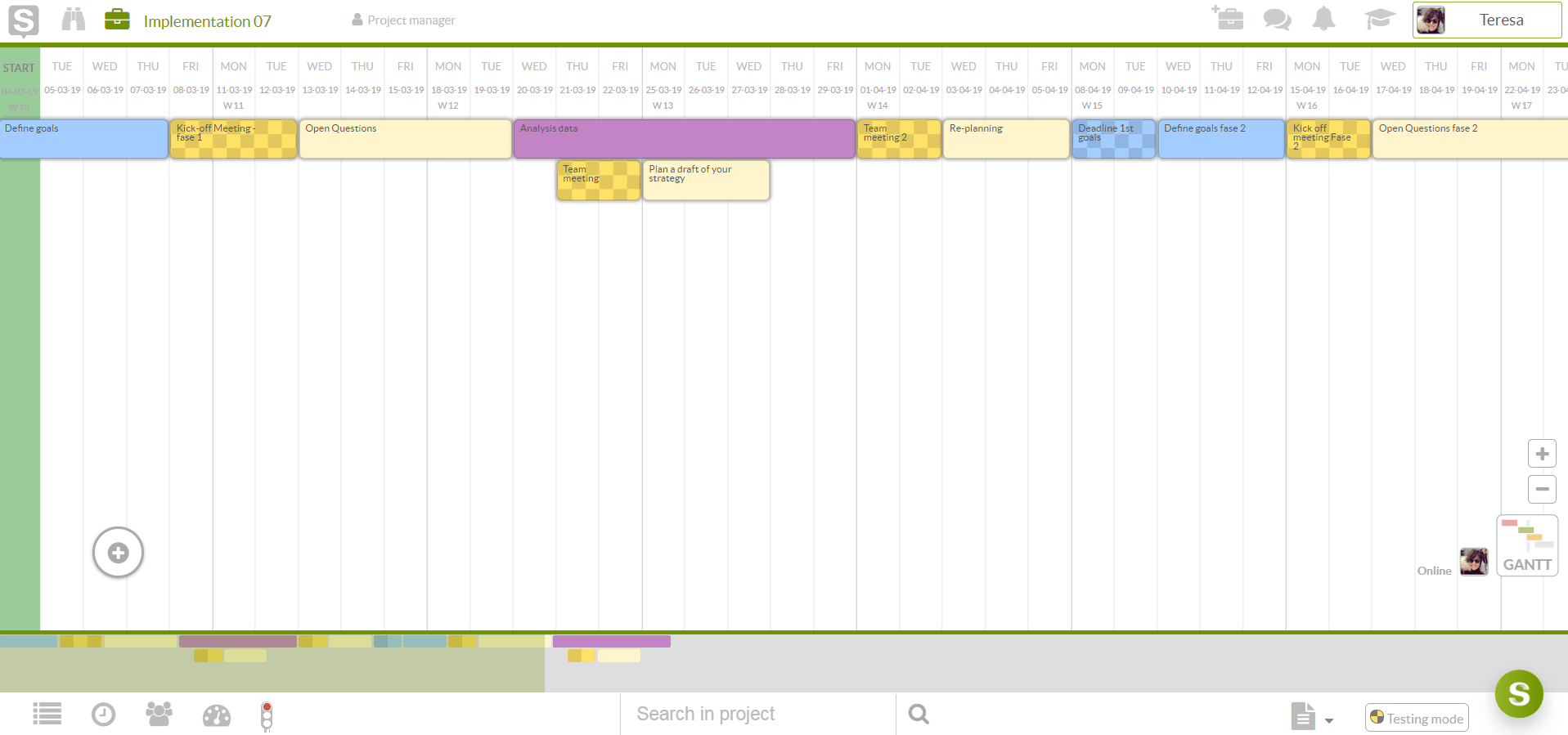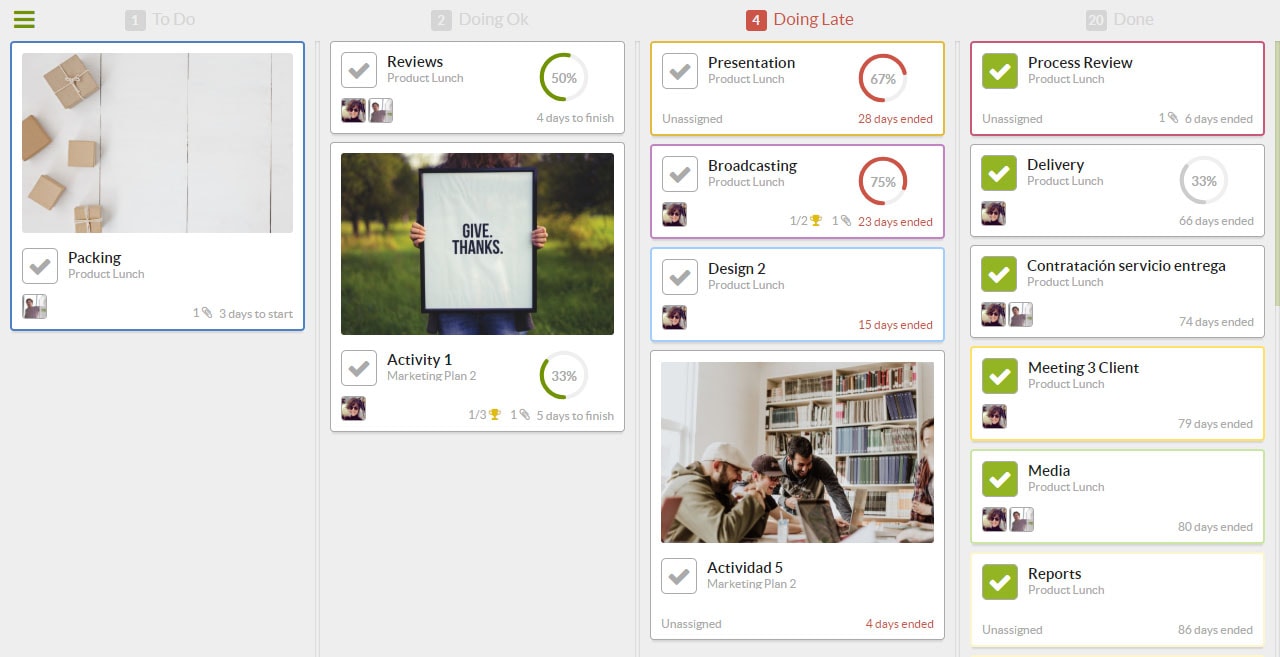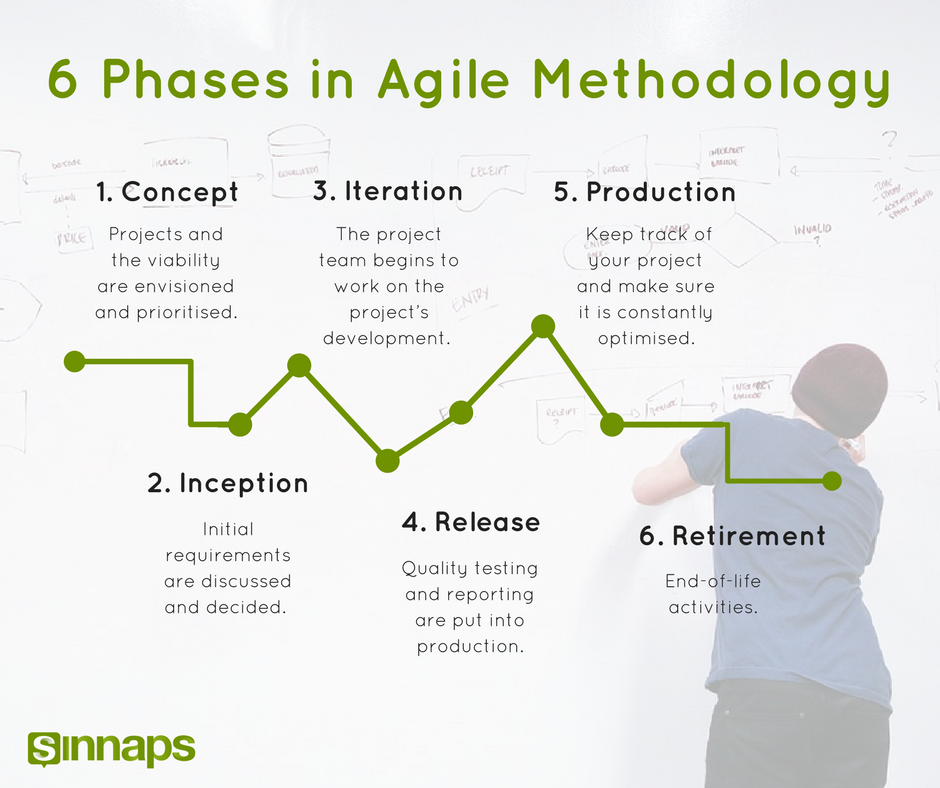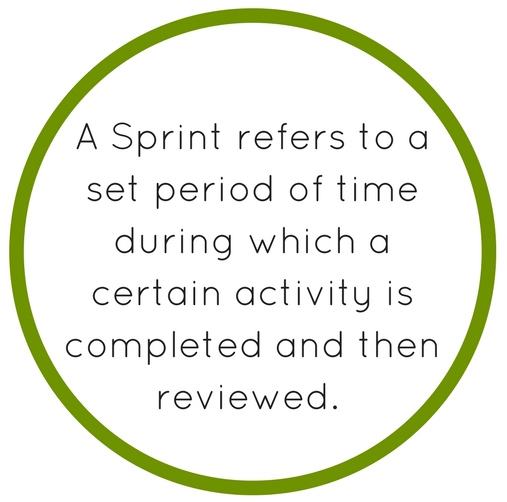There exist many ways to manage a project. Traditionally, it has moved from drawing up a Gantt-chart laboriously by hand to today’s wide range of project management software that is available such as Sinnaps, tool based on agile methodology.
An easy way to explain agile methodology to someone who is not familiar is to say that project management software utilises various methodologies to generate the most optimised scrum project plan and an agile method is one example. The Agile method is one of these.
Agile Project Management Tool

In this article, you will find the agile methodology explained, what agile methods mostly focus on and how it can help your project reach its goal successfully.
Índice
What is Agile Methodology Sprint?
Agile methodology Sprint is a set of planning and management techniques, derived from software development and based on the iterative and incremental execution of activities, where the requirements and solutions evolve according to the needs of the project.
The Agile workflow ‘method’ is more commonly referred to as a movement. Is agile a methodology then? Yes, it can be referred to as both a methodology and a movement. This description essentially encompasses its motivation to seek alternatives to traditional project management. The agile methodology is not just one method. An example of agile methodology sprint in project management is Scrum or Kanban, to name just two.
Agile Project Management with Kanban

Projects are complex and today, more than ever, are met with uncertainties and unpredictability. The agile methodology process seeks to respond to these uncertainties through incremental, iterative work cadences and empirical feedback.
After much criticism of sequential development, most notably by Dr. Winston Royce in 1970, it was stated that software shouldn’t be developed as if it were on an assembly line. Through a sequential method phases are broken up separately and the next phase cannot begin until the previous is completed. This is simply unrealistic for project management where projects contain various activities and phases that need to be completed simultaneously. Royce’s main argument was the lack of communication (one of the most important aspects of teamwork!) between the various stakeholders of a project.
The more traditional and sequential ‘waterfall’ methodology cannot compare to the optimisation of an agile method, especially towards modern project management. The agile methods mostly focus on allowing teams to work on a project and during its development to easily facilitate any changes or modifications needed to reach the project’s goal more effectively. The waterfall method does not allow for changes or modifications to be easily included during a project process and instead sets out everything before the project’s beginning, hoping that nothing will go wrong and that there won’t be a need for change.
Agile Methodology Overview
The agile working methodology or ‘movement’ allows project managers and other stakeholders to assess and examine the direction of the project during its life cycle. Sprints or iterations are regular and consistent which allow for a constant-growth model which team members follow. At the end of each agile sprint retrospective or iteration it is required that the project team deliver results in moving the project along.
From the emphasis placed on repeated abbreviated work cycles, the agile method is described as incremental. In comparison to the waterfall method, project teams have more than one chance to get each aspect of the project right. This dramatically increases project success rate. The continual revision of every aspect of the project allows for true optimisation and quality results. By allowing teams to stop and revise projects after every agile methodology sprint, modifications and changes are easily incorporated and the project can be steered in a new direction.
The agile methodology process adopts an ‘inspect and adapt’ approach to project management. This greatly reduces costs and time. Since project teams work in agile sprints, it allows stakeholders more opportunities to in a collaborate. The continual adaptation for which the agile method allows for is essential in today’s uncertain and sometimes unstable environment. Project team are empowered to re-plan instead of going ahead with a once-off planned project, unadaptable to change that is bound to fail. This allows for increased competitivity and preserves a project’s market relevance.
The agile methodology explained in terms of an actual sprint software and how it is implemented can be done by taking example from Sinnaps. The project management software’s implementation of agile methodology in project management allows you to view various project scenarios and predict the impact of potential changes. It is designed to plan software development projects based on iteration and agility. Speed and flexibility are prioritised by Sinnaps, one of the most innovate and easy-to-use agile project management tools. It’s an effective Wrike Alternative, other agile tool.
Agile Testing Methodology for Software Development

Agile Testing is a software testing practise that follows the principles of agile software development.Collaboration between the customer of the project and the project team plays a key role. Collaboration in general plays a significant role when it comes to agile testing and helps to align the development of the project with the needs of its stakeholders.
Advantages of Agile Testing in Agile Software Development:
- Agile Testing saves time and money. As we all know, in the business world, time is money so that’s always a plus.
- Less documentation to fill out and write up which also saves you time, money and effort.
- Regular feedback from the stakeholders and end-users of the project which means that the project can be completed to suit the end-user in the best way possible.
- Daily agile meetings held as part of the method help to determine issues and be prepared for them well in advance.
Testing is not a phase of the agile method. The phases will be explained later one. Testing is continuous throughout the project and ensure continuous progress. It helps the project to move along its path. Continuous feedback is generated so that the project can complete its goals to the specific requirements of the project user to its highest potential.
With the agile methodology everyone tests, which means teams, developers and other stakeholders whereas in the more traditional methodology only the team tests.
In agile testing continuous feedback in each iteration allows for a shortened feedback response time which in turn, means that resolving an issue that has arisen will cost less and take up less time. Any defects are seen to in each iteration which allows for a consistently clean code.
Instead of long documentation, agile testers focus more on the test as a whole rather than incidental details by using reusable checklists. Normally, with more traditional methods, testing is carried out after implementation while agile testing is carried out alongside implementation.
Agile Methodology Phases
As is the case with a project, the agile methodology process also goes through its own life cycle. There are six phases in agile methodology:

- Concept: Projects and the viability are envisioned and prioritised according to importance.
- Inception: A team is brought together, team members are individually identified, a fund is put in place and any initial requirements are discussed and decided.
- Iteration/Construction: The project team begins to work on the project’s development using software implemented with the agile method focusing on iteration requirements and feedback.
- Release: Quality testing, training, both internal and external and documentation and reporting are put into production.
- Production: The Agile methods helps to keep track of your project and make sure it is constantly optimised and ready to bounce back from any sudden changes or uncertainties.
- Retirement: End-of-life activities.
These six phases conclude the full Agile method lifecycle model. The case may be that an enterprise could have many different on-going projects. These project each come with their own sprints (explained soon), different product lines, varying internal and external customers and different business needs. It is important to have a well-structured and organised project management software such as Sinnaps that can help take care of simultaneous projects and keep the organised and monitored easily.
Agile Sprint Methodology
In project management, a ‘sprint’ refers to a set period of time during which a certain task or activity is completed and then reviewed.
Like the beginning of any project, at the beginning of an agile methodology sprint a meeting is held during which the sprint itself is planned. The customer and project team discuss the work that needs to be completed during the sprint. It is down to the project team to determine how much time they will need to complete certain amounts of work and up to the customer on the type of work that needs to be completed.
Every sprint duration is different and each one is determined by the Scrum Master who acts as the team’s facilitator. Sprint durations should be kept consistent after deciding on the first one. Generally, and on average a sprint lasts 30 days.
During a sprint, the customer is expected to step back and allow space for the project team to work. Daily stand up meetings are held to ponder the project’s progress and to make decisions and face challenges. The customer can attend, but only for an observing purpose. Only the scrum master or project manager has the power to interrupt the sprint, using scrum online tools.
When the agile methodology sprint comes to an end, the project team presents its completed work to the customer/project owner and the project owner uses the initially established criteria against which to compare if the work has been a success or failure.
Different Agile Methodologies
The Agile Method isn’t just the one method to be utilised in project management! It is comprised of a set of various methodologies that are classified as agile. There are many in number. These agile methods mostly focus on specific aspects of project management such as change adaptation, timeliness and flexibility. Some of the different agile methodologies include:
- Disciplined Agile Delivery (DAD): This method framework provides general guidance to help organizations streamline their processes in a manner that is context-sensitive. This, in turn, helps to provide a solid found for business agility and flexibility.
- Adaptive Software Development: Adaptive Software Development moves towards making practises and processes more adaptive. Adaptive Software Development focuses on collaboration and learning as a technique to build complex systems.
- Agile Modelling: This is a methodology for modelling and documenting software systems based on best practices. It is a collection of values and principles, that can be applied on an (agile) software development project.
- Kanban: This example of agile methodology is one which Sinnaps, the online project management app, has chosen to place great emphasis upon. Kanban is a method for placing emphasis on continual delivery while not placing too much on the shoulders of the development team. It is a process designed to help teams work together more effectively. Here, you can find a Kanban Tool and Methodology.
- Scrum: Scrum is also a method focused on helping teams work together more effectively. It is used for managing software delivery. It embraces iterative and incremental practices, helping organizations deliver working software at a more frequent rate. You can learn more about Scrum Methodology here.
- Extreme Programming (XP): This is a software development methodology intended to improve software quality and responsiveness to changing customer requirements. This is important in today’s constantly changing environment. Frequent releases are introduced which make way for more frequent checkpoints along the development of the project and creates a higher chance of overall success.
- Lean Software Development: LSD is an example of agile working methodology and works on lean principles that were adapted from the Toyota production system. The agile method is slowly becoming more and more pro-lean.
Overall, the goal of each of the agile methods is to help a project adapt to sudden changes and deliver on goals as quickly as possible. Each method is a slight variation on the phases of the software development.
Each project is different and so is each project’s process. Depending on how you project is developing it may be best to use a certain method. The case may be that both you and your friends team are using the same method, but because your projects are different your methods also look different.
Taking into consideration all the potential methods that exist and that can be implemented into project management software, it is important to remember that each come with their own set of advantages and disadvantages.
A good way to manage your project is by using a method that you thoroughly understand so that you can reap its benefits and have it work in your favour. This is exactly what Sinnaps keeps in mind. This online project management software utilises different aspects of various project management methodologies such as PERT, CPM and the Agile method to ensure that your project is optimised and completed successfully.
Now that you have a firmer grasp on what agile methodology is, here’s a little humour to go with it! 🙂

Maybe, this is interesting for you…
-
[…] Planning based on Agile Methodology […]
Escribe un comentario


Nice read.
Great work.